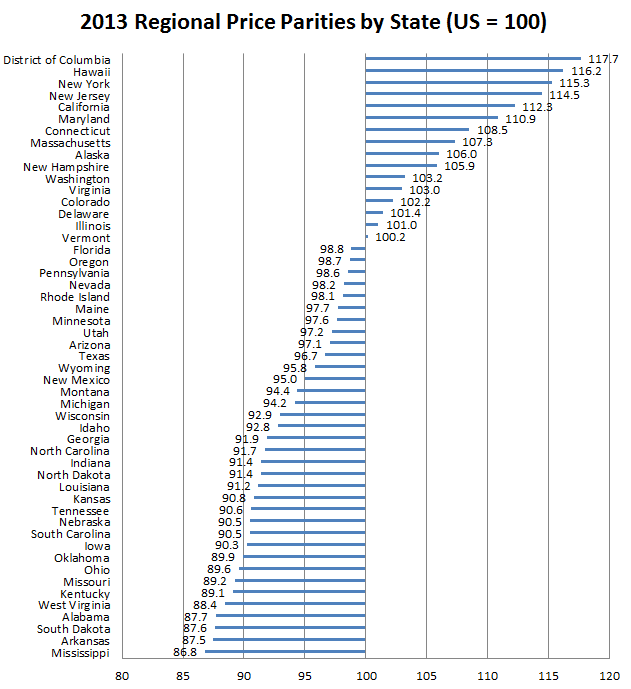How Much Is A $15 Minimum Wage is Worth in Your City?

By:
Pew Research Center released a map Monday that shows what the real purchasing power of someone earning the national $15 per hour wage—and, well, it varies.
As an example, Pew compared two different cities in two different states to illustrate how purchasing power can differ from city to city, state to state:
According to Pew, "[A] national $15 minimum would yield $17.08 worth of purchasing power in Macon, Georgia, but only $12.26 in New York City, once the differing price levels in the two cities are taken into account." The map below explains:
The map uses 2013 “regional price parities" (RPP) data for 381 metropolitan areas. "Regional Price Parities (RPPs) measure the differences in the price levels of goods and services across states and metropolitan areas for a given year," according to the U.S. Department of Commerce Bureau of Economic Analysis. "RPPs are expressed as a percentage of the overall national price level for each year, which is equal to 100.0."
 U.S. Department of Commerce Bureau of Economic Analysis - bea.gov
U.S. Department of Commerce Bureau of Economic Analysis - bea.gov
Thus explains the purchasing power difference between Macon, Georgia and New York City:
"So on average, prices in the New York metro area, which has an RPP of 122.3, are 22.3% higher than the nationwide average, while in Macon (RPP of 87.8) prices are 12.2% below average."
Shockingly enough, though, New York City's real purchasing power was not the worst in the nation: Honolulu is the most expensive metropolitan area, with a purchasing power of $12.24. Where can you get the most bang for your $15? "Beckley, West Virginia, has the lowest RPP of any metro area in the nation, so a $15 minimum would have the purchasing power of $19.23 there," Pew explains. And Allentown, Pennsylvania, is the only metropolitan area where $15 means $15, as Allentown has an RPP of precisely 100.
Why look at $15?
So, why did Pew examine $15 per hour? There has been a grassroots push for a $15 per hour minimum wage, which has recently seen victories in places such as Los Angeles (city and county), New York City (for fast food workers), Seattle, San Francisco, and other metropolitan areas. The Fight for $15 movement first began in New York City about two years ago, and has since picked up steam.
The current federal minimum wage is $7.25 per hour, and many states have raised their minimum wages to higher than the federal standard. In his 2014 State of the Union address, President Barack Obama called for a raising of the federal minimum wage. He proposed a $10.10 per hour national minimum wage. Since then, there have been bills introduced in Congress that raise the federal minimum wage higher to $12 per hour, and some even higher to $15 per hour. The $15 per hour minimum wage is also seeing support amongst Democratic candidates in the 2016 presidential race.
The growing movement comes from the reality that the current minimum wage is not enough to support workers and their families. Many people who work minimum wage, hourly jobs, including but not limited to fast-food workers or those who work at megastores such as Walmart, rely on pubic assistance (food stamps, Medicare) to make ends meet. In fact, the University of California, Berkeley Labor Center found that each year, low wages cost the U.S. taxpayers $152.8 billion in taxpayer money that goes towards public assistance. The Economic Policy Institute (EPI) estimates that if the minimum wage were raised to just $10.10 per hour, 1.7 million people would no longer have to rely on public assistance.
Check out ATTN:'s coverage of the Fight for $15 and do a little minimum wage myth-busting below:
Related: How Much Is Your $100 Worth in Every State?

